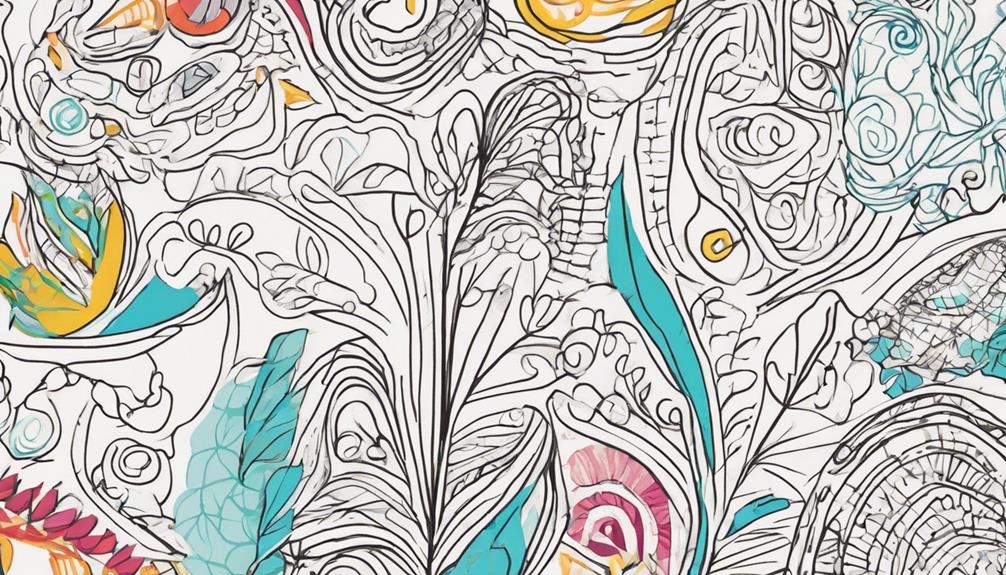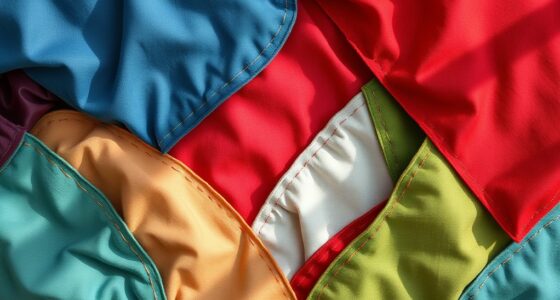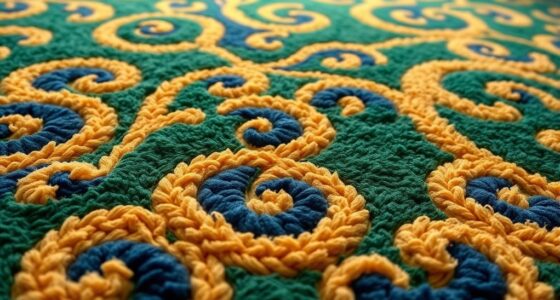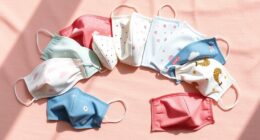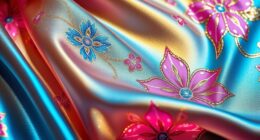Discover the realm of textile art, where artists use fibers, yarn, and fabric to craft intricate designs bursting with texture and vibrant colors. Uncover tapestries, sculptures, and wearable art that highlight the beauty of working with fabric. From age-old methods to cutting-edge techniques, textile art has grown alongside industrial advancements and innovative approaches. These creations hold deep cultural meaning, mirroring past events and societal beliefs. Despite encountering obstacles in gaining appreciation, textile artists are transforming views on modern art. Immerse yourself in the enchanting world of textile art and uncover a diverse tapestry of imagination and self-expression.
Key Takeaways
- Textile art involves creating artworks using fibers, yarn, or cloth.
- Techniques include weaving, knitting, embroidery, and quilting.
- Focuses on texture, color, and pattern in designs.
- Examples include tapestries, soft sculptures, and wearable art.
- Artists manipulate fibers to create intricate patterns and designs.
Definition of Textile Art
Exploring the world of fabric art involves creating artworks using various textiles like fibers, yarn, or cloth. The definition of fabric art encompasses a wide range of techniques, including weaving, knitting, embroidery, and quilting. Fiber artists use these techniques to create unique fabric works that can be functional or purely decorative. Textile design plays an essential role in the creation of art using textiles, with artists often focusing on texture, color, and pattern to convey their artistic vision.
Examples of fabric art include tapestries, soft sculptures, and wearable art pieces. Various types of needlework, such as cross-stitch and crewel embroidery, fall under the umbrella of fabric art. Textile production involves the manipulation of fibers to form intricate patterns and designs.
Contemporary artists in the field of fabric art experiment with new materials and concepts to push the boundaries of traditional techniques, creating innovative and thought-provoking pieces that challenge conventional notions of art.
Evolution of Textile Techniques

The evolution of textile techniques spans centuries, witnessing a transformation from ancient methods like weaving and embroidery to modern innovations driven by technology and creativity. Industrial advancements during the 18th century played an essential role in revolutionizing textile production. Mechanization of traditional techniques such as weaving and dyeing became widespread, leading to increased efficiency and output.
In the contemporary art scene, artists like Toshiko Horiuchi MacAdam and Nick Cave are pushing boundaries with their innovative approaches to textile art. They seamlessly integrate multimedia elements into their creations, adding a new dimension to the art form. Synthetic fabrics and dyes have also played a significant role in transforming textile art, offering a vast array of colors and possibilities for artists to experiment with.
Moreover, textile installations have gained prominence in art spaces, showcasing the fusion of traditional techniques with modern artistic concepts. This trend highlights the versatility and adaptability of textile art in capturing the imagination of viewers through immersive and engaging experiences.
Cultural Significance in Textile Art

Cultural significance in textile art is intricately woven into the fabric of societies, reflecting historical events, societal values, and traditions. Textile artists use complex designs and patterns to convey narratives, emotions, and symbolism unique to various cultures and communities. Through these creations, they showcase cultural imagery and religious symbolism, often denoting power, wealth, and social hierarchies. Additionally, textile art serves as a medium for resistance against political issues, celebrating heritage through traditional techniques and modern interpretations.
To explore further the cultural significance of textile art, consider the following table:
| Aspects | Examples |
|---|---|
| Historical Events | Textile art depicting revolutions, wars, or cultural shifts |
| Societal Values | Representing gender roles, social status, or community norms |
| Traditions | Using traditional techniques or motifs passed down through generations |
| Symbolism | Employing colors, symbols, or motifs with specific meanings |
Challenges Faced by Artists

Artists specializing in textile art often encounter significant obstacles when attempting to gain recognition and appreciation for their creative endeavors. Textile artists face challenges in securing exhibition opportunities, limiting their visibility and opportunities to showcase their work to a broader audience.
Misconceptions about textile art as merely a craft rather than fine art also hinder the validation and acceptance of their creations. Overcoming the traditional categorization of textiles as functional items rather than artistic expressions presents a common hurdle for these artists.
Breaking through conventional art categories and being acknowledged for the creativity and skill involved in their craft is a constant struggle for textile artists. Despite these challenges, textile artists continue to push boundaries and redefine the perception of their art form, demonstrating the intricate blend of tradition, innovation, and creativity that defines contemporary textile art.
Innovations in Contemporary Textile Art

Numerous contemporary textile artists are revolutionizing the art form through innovative techniques and multimedia integration. This evolution in contemporary textile art is marked by the use of artificial textiles that offer vibrant colors and new creative avenues for artists.
Textile installations are gaining prominence, with a focus on technical precision and aesthetic value, as seen in the works of artists like Chiharu Shiota and Louise Bourgeois.
The integration of modern technologies has allowed artists to experiment with unconventional materials, pushing the boundaries of traditional textile art. The fusion of technology with traditional methods is leading to the emergence of exciting new forms of expression in the domain of contemporary textile art.
- Artificial textiles and dyes offer intense colors and possibilities.
- Textile installations emphasize technical precision and aesthetic value.
- Modern technologies enable experimentation with unconventional materials.
- Fusion of technology with traditional methods leads to new forms of expression.
Frequently Asked Questions
How Do You Describe Textile Art?
When describing textile art, you consider the creative use of fibers like yarn and fabric to make art. Artists employ techniques like weaving, knitting, embroidery, and quilting to craft unique pieces.
Textile art has a long history blending practicality with aesthetics and is used to convey stories, emotions, and cultural themes.
In contemporary times, artists are exploring new materials and methods to push the boundaries of traditional textile art.
What Is the Point of Textile Art?
So, what's the deal with textile art, you ask?
Well, the point of it all is to liberate your creativity, emotions, and cultural vibes through fibers and fabrics.
Artists weave, knit, embroider, and quilt their way to expression, blurring the line between old-school crafts and modern art.
It's all about engaging your senses, visually and tangibly, offering a one-of-a-kind experience for anyone who lays eyes on it.
What Is Textile Explained?
Textile art involves creating art using textiles like fibers, yarn, and fabric. Artists employ techniques such as weaving, knitting, embroidery, and quilting to craft unique pieces.
They work with materials like natural fibers (cotton, wool, silk) and synthetics (polyester, nylon) to bring their visions to life.
This art form has a long history, evolving from practical to decorative purposes and continues to be pushed forward by contemporary artists experimenting with new techniques and materials.
How Do You Do Textile Art?
So, you want to immerse yourself in textile art? Well, grab your fibers and tools, and let's get creative!
Weaving, knitting, embroidery, or quilting – take your pick. Mix natural and synthetic materials for a modern twist.
Explore the rich history of this craft while adding your own flair. Join contemporary artists in pushing boundaries with new techniques and materials.
Get ready to stitch, knot, and sew your way to textile art mastery!
Conclusion
So next time you see a piece of textile art, remember that it's not just fabric and thread – it's a tapestry of history, culture, and creativity woven together.
Like a colorful quilt on a cold winter's night, textile art wraps you in warmth and beauty, inviting you to explore the intricate stitches and patterns that tell a story of human connection and expression.
Embrace the world of textile art and let it envelop you in its rich tapestry of emotion and imagination.




